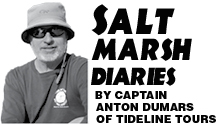From The Mountains To The Sea
Every grain of sand has a story to tell
 The early morning sun angled across a wide low-tide beach. Symmetrical wave-derived ripples cast striped shadows across the sand. Five brown pelicans surfed the wave troughs, practically skimming the water’s surface. A pod of bottlenose dolphin fished just beyond the break. As I strode along the hard-packed sand, I considered its provenance.
The early morning sun angled across a wide low-tide beach. Symmetrical wave-derived ripples cast striped shadows across the sand. Five brown pelicans surfed the wave troughs, practically skimming the water’s surface. A pod of bottlenose dolphin fished just beyond the break. As I strode along the hard-packed sand, I considered its provenance.
Our sands originate from the Appalachian Mountains. Billion-year old igneous boulders become cobbles. Cobbles become pebbles. Pebbles become sand, silt, and clay along the rock-tumbling journey from mountains to sea. Only the mountain’s most durable minerals, such as quartz and feldspar, survive the long, arduous journey to form a beach along the shoreline.
I collect sand as a hobby. Travelers bring me sand from all corners of the world. Sand tells the story of the region. Constituents of the sand give hints about both its source and present place of residence. I’ve got black magnetite sand from Guam, granitic sand from Easter Island, and carbonate sand from the Florida Keys and Bahamas. Folly visitors from Ohio recently sent me black volcanic sand from Iceland.
A couple of years ago, I took a family trip to northern California. I collected sand from Mavericks at Half Moon Bay, then from beaches north, all the way up to Willow Creek near the Oregon border. I noticed that samples south of the San Andreas Fault consisted of tan-gray colored sand, while gray-black sands dominated beaches north of the fault. Simply explained, several million years ago, granite-rich Rhode Island-size blocks from the Sierra Nevada Mountains broke loose, then slid northwestward along the San Andreas Fault’s southern margin. Today, they sit, eroding, along the Pacific Ocean near Half Moon Bay. Erosive ocean forces turn this granite into the tan-gray quartz sand found at Mavericks. The dark sands along the coast north of the fault come from an entirely different source, namely active volcanoes, such as Mount Lassen and Mount Shasta.
During our trip, we slept outside a few nights. Then I learned that mountain lions inhabit the area. That final night under the stars, all I could think about was mountain lions. Nervous bird chirps and dog barks stirred images of mountain lions crouching in the dark beyond the parked car. I gazed toward the sky and saw two bright stars shining down- mountain lion eyes. Then I smelled a skunk. Movement on the ground caught my eye. I froze when I saw the skunk just 10 feet from where I lay. Finally, it scurried off. I relaxed, gave up on sleep, then got up and made some coffee.
Capt. Anton DuMars is a coastal geologist and longtime Folly resident. You can contact Anton at sailspartina@gmail.com

